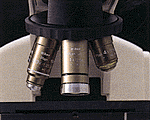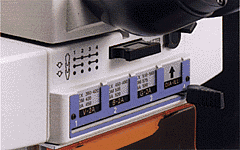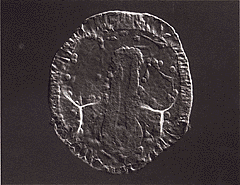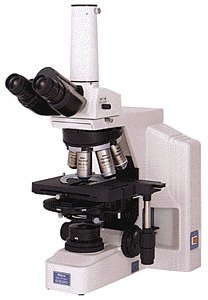| |
 Excellent Optical Performance
Excellent Optical Performance
No matter what the observation technique, you can always count on the same high level of optical performance from the E600/E400. The CFI60 optics deliver superb overall performance, with high resolution and contrast, Nikon's famous chromatic aberration free correction (CF) and top transmission rates. This make them the perfect tools for today's sophisticated research and clinical tasks.
Brightfield Observation
|
Brilliant, Sharp Images from
Low to High Magnifications
The E600/400 provice crystal-clear brightfield images with superior color fidelity. The 1X objective in particular is ideal for pathology and other applications requiring a larger visual and photographic field. CFI60 optics maintain incredible image sharpness over the broad range of magnifications from ultra low to high.
1X objective
Ideal for whole mount specimens like embryos or brain slices, the ultra-low 1X objective allows you to observe and photography the largest field of view possible.
Standard 22mm field of view
With a 22mm standard field of view, the E600/400 ensures clear images with minimal aberration and flare right up to the periphery of the field of view.
Optional ultra widefield eyepieces
The trinocular tubes F and T permit ultra-wide field observations with a field of view of 25mm simply by switching to the optional Ultra Widefield Eyepieces.
|
|
 1x objective
1x objective |
|
|
Epi-fluorescence
Epi-fluorescence Made Easy
A pronounced increase in the use of fluorescence techniques has been witnessed recently in research applications as well as clinical applications. The E600/E400 system as a whole excels at handling difficult fluorescence tasks, rendering images with superb clarity and high contrast. Flourescence microscopy has never been easier.
|
|
 |
|
Four-filter linear slider
The epi-fluorescence attachment accepts up to four fluorescence filter cubes. For example, it can accommodate one multi-band filter plus three corresponding single-band filters, or any combination of filters you need.
|
|
 |
|
Quick filter slider switching
With the new mechanism, as few as two filter blocks can be selected by pulling the filter lever out one click stop, or alternatively, you can pull the lever out two clicks and lock the lever in the current position for brightfield or some other specific tests.
|
|
 |
|
Easy filter replacement
Filter replacement is now easier than ever, as the filter assembly can be held in place by pulling the lever out into the lock position. Each filter block is fixed by a self-leveling clamp screw providing extreme registration between filter positions.
|
|
 |
|
Front shutter
A unique shutter control is located up front, just below the eyepiece tube, for easy access in dimly-lit rooms; no need to remove your eye from the eyepiece or feel around for the shutter slider to prevent the specimen from fading.
|
|
 |
|
CF collector lens
Ensures even illumination over the entire specimen area. This collector lens is color corrected for multi-color staining applications using a variety of excitation filters. It is ideal for applications like F.I.S.H. or triple stained fluorescence imaging.
|
|
 |
|
Plan Fluor series objectives
Featuring both superb image flatness and high UV transmission rates, these objectives are ideal for epi-fluorescence observations.
|
|
 |
|
A wide choice of filter options
Filters to cover a multitude of application needs.
|
|
 |
|
Phase Contrast
High Contrast and definition
This technique ensures well-defined, high contrast images and neutral background coloration, regardless of the magnification range.
|
|
 |
|
Simple polarizing
Ideal for observing amyloid and crystals
Set up simple polarizing observation by installing the polarizer over the field lens and the intermediate tube type analyzer. This accessory will allow for an ultra-widefield field of view of 25mm.
|
|
 |
|
 Simple polarizing set B
Simple polarizing set B
(swing-out type) |
|
 Simple polarizing set A
Simple polarizing set A |
|
|
Darkfield
Easier operation in microbiology and hematology screening
You can choose between a dry or ultra darkfield oil type condenser. An optional condenser expander lens is also available for brighter illumination.
|
|
 |
|
 Darkfield condensers
Darkfield condensers
(dry, oil) |
|
 Expander lens
Expander lens |
|
|
Nomarski DIC
Observe living cells in high definition DIC
The Senarmont method was chosen to optimize our Nomarski DIC system and to enhance ease of operation while eliminating the need to adjust the DIC contrast from above the objective. You can observe unstained living cells and microorganisms in 3D-relief-like images with unparallelled optical stability, and control the contrast from the base of the microscope for greater ease of use. The shear angle of our DIC system has been designed to provide increased contrast and is ideal for observing specimens like nematodes and Drosophilia embryos. The seven position Universal Turret Condenser accommodates three DIC, three phase and one brightfield positions. A dry 0.9 flip-out condenser top and 1.4 oil immersion top are available. An optional expander lens is available for use with the oil immersion 1.4 condenser for high N.A. DIC applications like video enhancement.
|
|


Nomarski DIC set |
|
The Senarmont method
Contrast adjustment is accomplished by rotating the polarizer on the field lens, eliminating the risk of annoying image shifts. The revolving nosepiece houses individual prisms for each objective, thus guaranteeing optimal shear to match the N.A. of the condenser top lens and the objective. |
|
 |
|
|


 Excellent Optical Performance
Excellent Optical Performance